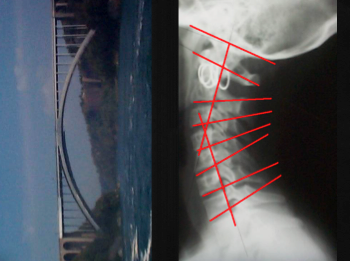DID YOU KNOW THIS?

Last week a patient told me one of his friends was opting neck surgery because her orthopedic surgeon told her there was no other option. She was lied too!
A curve (even your cervical neck curve) is the strongest supporting engineering structure on planet earth. You and your kids were born with one in your neck for a reason-Longevity! It’s the same reason why some of the most iconic engineering structures on the planet have curves built into there architecture. Structures like Hoover Dam, The Golden Gate Bridge, and the St. Louis Arch.
The Following is the “Medical Approach” to treat the loss of your cervical curve or the reversal of it. The University of Maryland Medical Center published it. It is not the corrective Chiropractic approach.
Loss of your cervical curve is a serious condition
The symptoms of cervical kyphosis (or reversed neck curve) can range from a simple nuisance to a severe deformity, which can lead to paralysis if untreated. Symptoms can include mechanical neck pain if the kyphosis is due to degenerative changes in the cervical spine. You may have a reduced range of motion in the neck. This means you may not be able to rotate your neck fully and you may have difficulty looking up for any length of time. If the kyphosis is severe, you may begin to have problems with the nerve roots or the spinal cord, due to pressure on the nerves in the cervical spine. This may cause: weakness in the arms or legs, loss of grip strength, or difficulty walking due to spasticity in the legs. You may have problems controlling your bladder or bowels. In extremely severe cases that are left untreated, paralysis from the neck down may even result.
**In our office this is the specific reason why we see so many positive changes with people with fatigue, breathing issues, chronic digestive issues, headaches, and other conditions when the cervical curve is restored. Below is what the mainstream medical approach is. After please read the chiropractic approach.
Treatment (Medical approach)
Conservative Treatment (Non-surgical)
Treatment for cervical kyphosis is very much dependent on whether there is pressure on the spinal cord. If there is, then surgery may be suggested immediately. If the cervical kyphosis is primarily causing pain and concern about your appearance, then your doctor may consider trying to control your pain and deformity with: a physical therapy program, mild pain medications, and a neck brace.
Surgical Treatment
Excessive kyphosis can be treated, and the methods of treatment have evolved over time. Today, surgery to treat cervical kyphosis is usually a spinal fusion combined with “segmental instrumentation”. This means that some type of metal plate or rod is used to hold the spine in the proper alignment in order to straighten it. If the deformity is fixed (meaning that it is not getting worse), and there are no neurological problems due to pressure on the spinal cord, surgery is usually not recommended because the problem is not going to get worse. Spinal surgery is serious, and unless necessary, it is rarely recommended. However, if the fixed deformity is accompanied by neurological problems from pressure on the spinal cord, surgery becomes more likely. Surgical correction is the most difficult type of treatment for cervical kyphosis. Surgery may require an operation from the front of the spine to relieve the pressure on the spinal cord, and an operation from the back to fuse the spine and prevent the kyphosis from returning.
- Anterior Cervical Fusion
- Posterior Cervical Fusion
Source: Cervical Kyphosis | University of Maryland Medical Center http://umm.edu/programs/spine/health/guides/cervical-kyphosis#ixzz3Gg8l1CIm University of Maryland Medical Center
Chiropractic Approach
- It is not hot packs, electrical muscle stimulation, ultra-sound! That restores your curve. It is a specific program of correction that involves specific chiropractic adjustments; yoga based mobility exercise, isometric exercise, as well as passive and active corrective equipment used at home. No drugs, no surgery, and no $50,000 price tag. Price tag in our office for a corrective care plan is roughly 3% of that. You don’t have to sign a consent waiver and you don’t have to take any the dangerous medications.
‹ Back




Comments